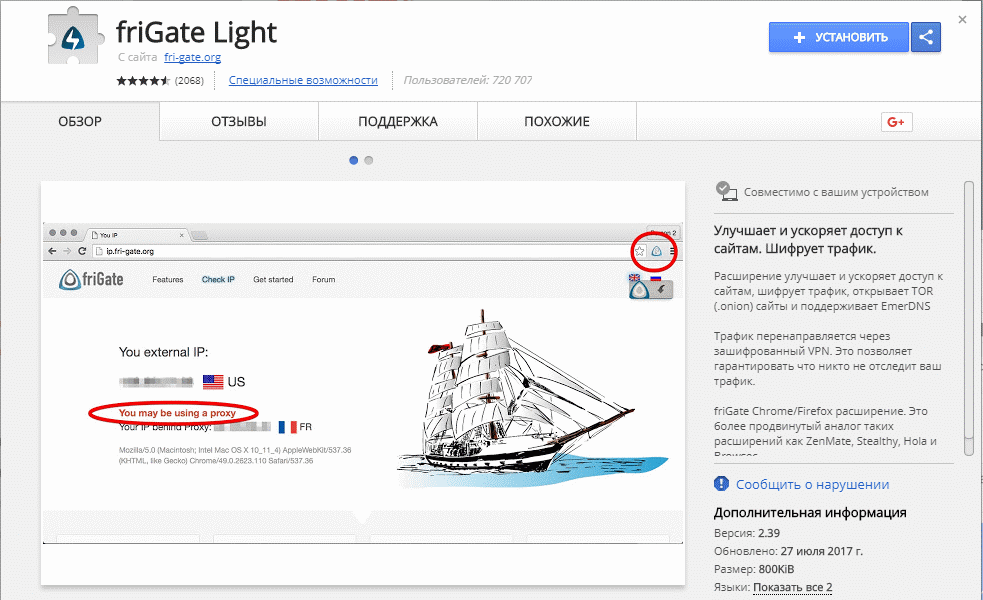friGate is a browser addon for Chrome and Firefox to quickly help you bypass Internet filtering without you having install software in your computer. The extension has many configuration options, advanced computer users will like the many preferences that this proxy addon allows you. friGate requires a little more work to set up than other one click proxy addons like Zenmate, but as an upside, you can fine grain it to your personal needs.
The default friGate behaviour is to automatically switch on the browser proxy when it detects that the site you are visiting is not available, the extension compares the URL you visit against a list of sites stored in preferences to know that the site really exists. A tiny right hand side window on top of your browser lets you know if the site you visit is blocked by the administrator and shows the flag of the proxy’s country being used to bypass it.
The list of sites that friGate unblocks is made of over a hundred Russian warez, casinos and torrent sites, most people will want to add productive sites to the list, like YouTube or Twitter. This is easy to do, a short video tutorial in friGate website exhibits step by step instructions. In Chrome you have to go to the browser Extensions>friGate CDN>Options compose a list name, click on “Add list” and you will see a new window where to add sites that you would like to visit with friGate proxy. There is the choice of only using the proxy when the site is blocked or choose to have the proxy always switched on regardless of if the site is blocked or not.
- Frigate, has a built-in graphics viewer (with thumbnails and slideshow functionality) that internally supports many popular file formats as well as a built-in text, rich text and DBF files viewer and editor. It accepts several plugins that you can download from the official site.
- It's just for Vietnameses or people cant log in FB.
- Frigates of the Modern Navy As is the case with many of the warships we discuss here on Ships of the Line, the 2nd World War altered the roles and classifications of these surface warships. The term Frigate was resurrected by the Royal Navy, and it only shared the name with the historical Frigates of the Age of Sail.
Firefox gives you quick access to your most recently used sites to help you get where you’re going fast, without hassle. SHARE ANYTHING IN A FEW TAPS The Firefox web browser makes it easy to share links to web pages or specific items on a page with easy, quick access to your most recently used apps like Instagram, Twitter, WhatsApp, and more.
When you are visiting a site with the proxy on you can manually change the location, I was able to switch in between two different serves, one in Germany and another one in the Netherlands. The downside for me was that there was no USA proxy server, this meant that I couldn’t use friGate to stream US georestricted content like Slacker radio. This can be fixed by entering your own proxy IP and port number in friGate settings but there is no way to specify a username and password for the proxy, it will have to be an open proxy, not thrilling.
I didn’t notice any speed decrease when browsing the Internet with friGate proxy, I was unable to tell if I was on my ISP connection or the proxy other than by a small friGate indicator in the browser. I liked that I could browse the Internet with my own computer IP in one tab and visit a different site with an anonymous proxy in a different tab, all automatically. A tool like this, if added to a portable Internet browser, can be used in an Internet cafe or library to bypass filtering, as long as filtering it is not done at DNS level, in which the DNS servers would have to be changed.
friGate CDN Chrome browser extension
Another aspect is the encrypted connection to stop a network administrator from seeing what sites you visit, there was no information on what algorithm and protocol friGate is using to encrypt the connection.
The project is financed injecting adverts when you browse the Internet, just like HotStopShield does but in friGate you can disable the adverts going to settings if you find them too intrusive, I didn’t think they were, there were no pop ups or too many windows.
Overall, I would be happy to use this proxy extension for low level privacy. The idea of this proxy is to help you get around Internet censorship and as long as the filter is software based it should work. If you find yourself somewhere the DNS has to be changed and you can’t access it, set up a Secure Shell SSH proxy tunnel instead.
Most problems with Firefox can be fixed by following the troubleshooting methods described below. Try these steps in order. If one doesn't work, move on to the next one. If you need extra help with any of this, we have a community of volunteers standing by.
Table of Contents
- 8Other solutions
Sometimes problems can be fixed by simply restarting your computer and then starting Firefox again.
Many problems with loading web pages can be resolved by clearing Firefox's cookies and cache:
- Click on the menu button to open the menu panel.Click the Library button on your toolbar. (If you don't see it there, click the menu button then click Library.)
- Click History and select Clear Recent History….
- In the Time Range to clear: drop-down, select Everything.
- Below the drop-down menu, select both Cookies and Cache. Make sure other items you want to keep are not selected.
- Click .
Firefox Safe Mode is a troubleshooting mode that disables extensions, uses the default theme, turns off hardware acceleration and uses default toolbar settings, among other changes (see this article for details). To start Firefox in Safe Mode:
- Click the menu button , click Help, select Troubleshoot Mode… and click in the Restart Firefox in Troubleshoot Mode? dialog.Note: You can also start Firefox in Troubleshoot Mode by holding down the shift key while starting Firefox.holding down the option key while starting Firefox.quitting Firefox and then going to your Terminal and running:
firefox -safe-mode
You may need to specify the Firefox installation path (e.g. /usr/lib/firefox)Click the menu button , click Help, select Restart With Add-ons Disabled… and click in the Restart With Add-ons Disabled dialog.Note: You can also start Firefox in Safe Mode by holding down the shift key while starting Firefox.holding down the option key while starting Firefox.quitting Firefox and then going to your Terminal and running:firefox -safe-mode
You may need to specify the Firefox installation path (e.g. /usr/lib/firefox) - In the next Firefox Safe Mode dialog, click .
- Check whether your problem is still happening while in Safe Mode.

- If the problem still happens in Safe Mode, go on to step 4.
- If the problem does not happen in Safe Mode, follow these instructions to troubleshoot extensions, themes and hardware acceleration.
Firefox Troubleshoot Mode is a diagnostic mode that disables extensions, uses the default theme, turns off hardware acceleration and uses default toolbar settings, among other changes (see this article for details). To start Firefox in Troubleshoot Mode:
- Click the menu button , click Help, select Troubleshoot Mode… and click in the Restart Firefox in Troubleshoot Mode? dialog.Note: You can also start Firefox in Troubleshoot Mode by holding down the shift key while starting Firefox.holding down the option key while starting Firefox.quitting Firefox and then going to your Terminal and running:
firefox -safe-mode
You may need to specify the Firefox installation path (e.g. /usr/lib/firefox)Click the menu button , click Help, select Restart With Add-ons Disabled… and click in the Restart With Add-ons Disabled dialog.Note: You can also start Firefox in Safe Mode by holding down the shift key while starting Firefox.holding down the option key while starting Firefox.quitting Firefox and then going to your Terminal and running:firefox -safe-mode
You may need to specify the Firefox installation path (e.g. /usr/lib/firefox) - In the next Open Firefox in Troubleshoot Mode? dialog, click .
- Check whether your problem is still happening while in Troubleshoot Mode.


- If the problem still happens in Troubleshoot Mode, go on to step 4.
- If the problem does not happen in Troubleshoot Mode, follow these instructions to troubleshoot extensions, themes and hardware acceleration.
Some Firefox issues can be caused by a problem with one of the Firefox program files. Follow these steps to completely remove and reinstall Firefox. This process will not remove your Firefox profile data (such as bookmarks and passwords), since that information is stored in a different location.
- Download and save the installer for the latest official version of Firefox from mozilla.org.
- Exit Firefox (if open): Click the Firefox menu and select Exit.Click the Firefox menu at the top of the screen and select Quit Firefox.Click the Firefox menu and select Quit.
- You may want to make a note of the Mozilla Firefox program folder location (right-click the Firefox desktop icon, select Properties from the context menu and click the Shortcut tab) since there may be leftover files and folders after you uninstall Firefox that should be removed for a clean reinstallation.
- Uninstall Firefox from your computer.
- Delete the Firefox program folder, which is normally found in one of these locations by default:
- C:Program FilesMozilla Firefox
- C:Program Files (x86)Mozilla Firefox
- Reinstall Firefox using the installer you downloaded earlier - see How to download and install Firefox on Windows for instructions.
- Download the latest official version of Firefox from mozilla.org.
- Quit Firefox: Click the Firefox menu and select Exit.Click the Firefox menu at the top of the screen and select Quit Firefox.Click the Firefox menu and select Quit.
- Uninstall Firefox from your computer by opening the Applications folder in the Finder and dragging the Firefox application to the Trash.
- Reinstall Firefox - see How to download and install Firefox on Mac for instructions.
- Download the latest official version of Firefox from mozilla.org.
- Quit Firefox: Click the Firefox menu and select Exit.Click the Firefox menu at the top of the screen and select Quit Firefox.Click the Firefox menu and select Quit.
- Uninstall Firefox - If you installed Firefox with the distro-based package manager, you should use the same way to uninstall it - see Install Firefox on Linux for details. If you downloaded and installed the binary package from the Firefox download page, simply remove the folder firefox in your home directory to uninstall Firefox.
- Reinstall Firefox - see Install Firefox on Linux for instructions.
Now start Firefox and check to see if your problem has been fixed. If it hasn't, continue with the next troubleshooting method.
The Refresh Firefox feature can fix many issues by restoring your Firefox profile to its default state while saving your essential information.- Click this Refresh Firefox button directly, if you are viewing this page in Firefox. This won't work if you are using a different browser or a mobile device.
- You can also find a Refresh Firefox button at the top of the Firefox about:supportTroubleshooting Information page.
- To continue, click in the confirmation window that opens.
- Firefox will close to refresh itself. When finished, a window will list your imported information. Click and Firefox will open.

Sometimes files in your Firefox profile folder that correspond to the essential information that a Firefox Refresh doesn't remove (such as bookmarks and browsing history) may be causing the issue. You can create a new, additional profile which will not contain any of your old Firefox data. See the Profile Manager - Create, remove, or switch Firefox profiles article for instructions.
If you've tried all of these troubleshooting methods, and you're still having problems, here are some other solutions you can try:

Check browser internals
The Firefox Task Manager (about:performance page) lets you see what tabs or extensions are slowing down Firefox. Telemetry Data shared with Mozilla (about:telemetry page) contains detailed data about performance, hardware, usage and customization. The Troubleshooting Information page (about:support page) includes other about: page links and troubleshooting resources. (For a list of all about: pages, enter about:about in the address bar.)
Check for conflicts with your Internet security software
Some Internet security software (including antivirus, antispyware, and firewall programs) can cause problems with Firefox including blocking it from opening websites, crashes, and more. Often you can open the program's settings, remove Firefox from its list of allowed or trusted programs, and it will be re-detected and things should start working again. If your program is listed at the Configure firewalls so that Firefox can access the Internet article, you can get specific instructions for how to properly reconfigure it.
Frigate Dns Firefox
Check for malware
Malware (short for 'malicious software') can cause problems with Firefox. Periodically, you should scan your system for viruses, spyware, or other malware. For more information, see Troubleshoot Firefox issues caused by malware.
Frigate Firefox Addon
Based on information from Standard diagnostic - Firefox (mozillaZine KB)
